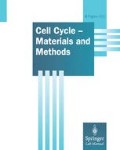Abstract
An essential and probably primary task in the study of cell cycle related processes is the synchronization of cells into specific cell cycle phases. Cell synchronization improves conditions by which an actual process under scrutiny can be studied and helps clarify linkage of the process to a particular cell cycle phase transition. In this chapter we will provide methods that have proven effective in synchronizing mammalian cells into defined cell cycle phases. We will discuss the advantages and disadvantages of each procedure and point to some key situations where such procedures have been employed successfully in the biochemical dissection of cell cycle control processes. Our focus here will be on the use of chemicals or growth restriction conditions to synchronize exponentially growing cells. We will present methodology to arrest cells in G0/G1, G1/S, G2 and mitosis-like states (Fig. 1). We will discuss the use of (1) serum starvation, isoleucine-withdrawal and chemicals (lovastatin, mimosine) for arrest of cells in a G0-like or G1-like state, (2) S phase blocking agents (aphidicolin, hydroxyurea, thymidine), (3) DNA damaging agents to produce G1 and/or G2 arrested cells, and (4) no- codazole to arrest cells in a mitotic state. Alternative nonchemical strategies using centrifugal elutriation as a basis for cell synchronization are discussed in the chapter by Marracino and Keng (Part One). Monitoring procedures to validate the success and selectivity of the arrest procedure, and subsequent cell cycle progression of the synchronize cohort will be discussed in the chapter by Giunta and Pucillo (Part One). Taken together, these chapters will appraise the currently available techniques that are commonly used for mammalian cell synchronization and provide the reader with methodology applicable to the study of a wide variety of cell cycle processes.
Access this chapter
Tax calculation will be finalised at checkout
Purchases are for personal use only
Preview
Unable to display preview. Download preview PDF.
References
Bootsma D, Budke L, Vos O (1964) Studies on synchronized divisions of tissue culture cells initiated by excess thymidine. Expt Cell Res 33:301–304
Burhans WC, Vasselev LT, Caddie MS, Heintz NH, DePamphilis MD (1990) Identification of an origin of bi-directional replication in mammalian chromosomes. Cell 62: 955–965
Campisi J, Morreo G, Pardee AB (1984) Kinetics of G1 transit following brief starvation for serum factors. Expt Cell Res 152:459–462
Dijkwel PA, Hamlin JL (1992) Initiation of DNA replication in the DHFR locus is confined to the early S period in CHO cells synchronized with the plant amino acid mimosine. Mol Cell Biol 12:3715–3722
Girard F, Strausfeld U, Fernandez A, Lamb NJC (1991) Cyclin A is required for the onset of DNA replication in mammalian fibroblasts. Cell 67:1169–1179
Heintz NH, Hamlin JL (1982) An amplified chromosomal sequence that includes the gene for DHFR initiates replication within specific restriction fragments. Proc Natl Acad Sci USA 79:4803–4087
Heintz N, Sive HL, Roeder RG (1983) Regulation of human histone gene expression: Kinetics of accumulation and changes in the rate of synthesis and the half-lives of individual histone mRNAs during the HeLa cell cycle. Mol Cell Biol 3:539–550
Keyomarsi K, Sandoval L, Band V, Pardee, AB (1991) Synchronization of tumor and normal cells from G1 to multiple cell cycles of lovastatin. Cancer Res 51:3602–3609
Lalande M (1990) A reversible arrest point in late G1 phase of the mammalian cell cycle. Exp Cell Res 186:332–339
Morla AO, Draetta G, Beach D, Wang JYJ Reversible tyrosine phosphorylation of cdc2: dephosphorylation accompanies activation during entry into mitosis. Cell 58:193–203
Mosca PJ, Dijkwel PA, Hamlin JL (1992) The plant amino acid mimosine may inhibit initiation of origins of replicaiton in CHO cells. Mol Cell Biol 12:4375–4383
O’Connor PM, Kohn, KW (1992) A fundamental role for cell cycle control in the chemosensitivity of cancer cells. Sem Cancer Biol 3:409–416
O’Connor PM, Ferris DK, Pagano M, Draetta G, Pines J, Hunter T, Longo DL, Kohn KW (1993a) G2 delay induced by nitrogen mustard in human cells affects cyclin A/cdk2 and cyclin B l/cdc2 complexes differently. J Biol Chem 268:8298–8308
O’Connor PM, Jackman J, Jondle D, Bhatia K, Magrath I, Kohn KW (1993b) Role of the p53 tumor suppressor gene in cell cycle arrest and radiosensitivity of Burkitt’s lymphoma cell lines. Cancer Res 53:4776–4780
Pagano M, Pepperkok R, Verde F, Ansorge W, Draetta G (1992) Cyclin A is required at two points in the human cell cycle. EMBO J 11:961–971
Pardee AB (1974) A restriction point for control of normal animal cell proliferation. Proc Natl Acad Sci USA 71:1286–1290
Pardee AB (1989) G1 events and regulation of cell proliferation. Science 246:603–608
Pines J, Hunter T (1989) Isolation of a human cyclin cDNA: Evidence for cyclin mRNA and protein regulation in the cell cycle and for interaction with p34cdc2. Cell 58: 833–846
Schimke RT, Kung AL, Rush DF, Sherwood SW (1991) Differences in mitotic control among mammalian cells. Cold Spring Harbor Symp Quant Biol 56:417–425
Stein GS, Borun TW (1972) The synthesis of acidic chromosomal proteins during the cell cycle of HeLa cells. J Cell Biol 52:292–296
Tobey RA, Crissman HA (1972) Preparation of large quantities of synchronized cells in late G1 in the pre-DNA replicative phase of the cell cycle. Expt Cell Res. 75:460–464
Author information
Authors and Affiliations
Editor information
Editors and Affiliations
Rights and permissions
Copyright information
© 1996 Springer-Verlag Berlin Heidelberg
About this chapter
Cite this chapter
O’Connor, P.M., Jackman, J. (1996). Synchronization of Mammalian Cells. In: Pagano, M. (eds) Cell Cycle — Materials and Methods. Springer Lab Manual. Springer, Berlin, Heidelberg. https://doi.org/10.1007/978-3-642-57783-3_6
Download citation
DOI: https://doi.org/10.1007/978-3-642-57783-3_6
Publisher Name: Springer, Berlin, Heidelberg
Print ISBN: 978-3-540-58066-9
Online ISBN: 978-3-642-57783-3
eBook Packages: Springer Book Archive

